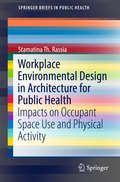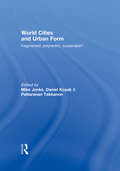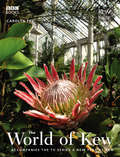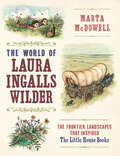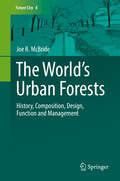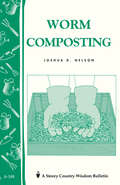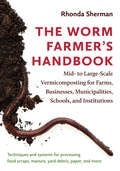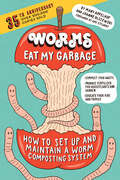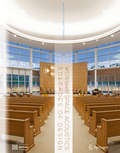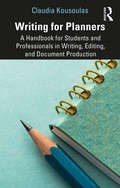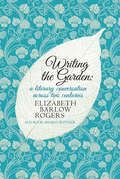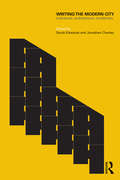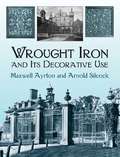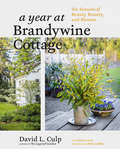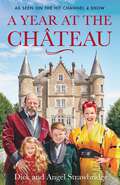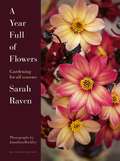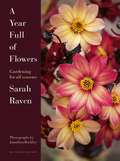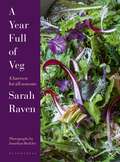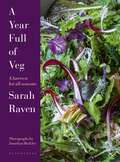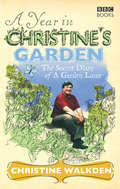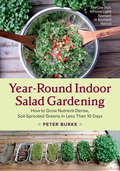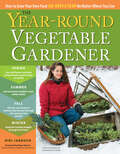- Table View
- List View
Workplace Environmental Design in Architecture for Public Health: Impacts on Occupant Space Use and Physical Activity (SpringerBriefs in Public Health)
by Stamatina Th. RassiaThis concise volume analyzes the potential for the workplace environment—where so many people spend so much of their day—to improve workers’ capacity for health and wellness. It pinpoints the link between sedentary lifestyles and poor health, and explores the role of office spatial design in encouraging physical activity to promote physical activity, health and prevent disease. The featured research study tracks workers’ movement in a variety of office layouts, addressing possible ways movement-friendly design can co-exist with wireless communication, paperless offices, and new corporate concepts of productivity. From these findings, the author’s conclusions extend public health concepts to recognize that influencing population-wide levels of activity through office architectural design alone may be possible. This SpringerBrief is comprised of chapters on : Physical activity and disease: Theory and practice Space-use and the history of the office building Identifying factors of the office architectural design that influence movement, Interdisciplinary research methods in studying worker physical activity, decision-making and office design characteristics The KINESIS model for simulating physical activity in office environmentsThe questions and potential for solutions in Workplace Environmental Design in Architecture for Public Health will interest and inform researchers in interdisciplinary topics of public health and architecture as well as graduate and post-graduate students, architects, economists, managers, businesses as well as health-conscious readers.
World Cities and Urban Form: Fragmented, Polycentric, Sustainable?
by Mike Jenks Daniel Kozak Pattaranan TakkanonThis book presents new research and theory at the regional scale showing the forms metropolitan regions might take to achieve sustainability. At the city scale the book presents case studies based on the latest research and practice from Europe, Asia and North America, showing how both planning and flagship design can propel cities into world class status, and also improve sustainability. The contributors explore the tension between polycentric and potentially sustainable development, and urban fragmentation in a physical context, but also in a wider cultural, social and economic context.
World Cities and Urban Form: Fragmented, Polycentric, Sustainable?
by Mike Jenks Daniel Kozak Pattaranan TakkanonThis book presents new research and theory at the regional scale showing the forms metropolitan regions might take to achieve sustainability. At the city scale the book presents case studies based on the latest research and practice from Europe, Asia and North America, showing how both planning and flagship design can propel cities into world class status, and also improve sustainability. The contributors explore the tension between polycentric and potentially sustainable development, and urban fragmentation in a physical context, but also in a wider cultural, social and economic context.
The World of Kew
by Carolyn FryWithout plants, there would be no life on earth. Kew Gardens is famous for its breathtaking displays of flowers and tree,s but this World Heritage Site is also a globally important scientific and historical organization. Scientists and gardeners use the plants and knowledge that have been collected at Kew since the eighteenth century to advance understanding of the earth's environment and of how plant lfe can be used for human benefit. Published to accompany the ten-part BBC2 series A New Year at Kew, this fascinating book takes us behind the scenes to show the extraordinary range of work carried out at Kew Gardens and Wakehurst Place - home to the Millenium Seed Bank - and by Kew staff overseas. From using forensic botant to micropagating plants facing extinction, from investigating herbal cures from Alzheimer's disease to replanting the volcano-ravaged island of Montserrat, the book shows us aspects of Kew's work that are largely hidden from view abut the benefits of which are far reachingl In the process it provides an absorbing and accessible introduction to such topical subjects as biodiversity, practical conservation and economic botany. Lavishly illustrated and filled with engrossing stories and engaging characters, this book brings to life the world of Kew and the global importance of its work.
The World of Laura Ingalls Wilder: The Frontier Landscapes that Inspired the Little House Books
by Marta McDowellLushly illustrated with beloved images and quotations from the Little House series, The World of Laura Ingalls Wilder, by New York Times bestselling author Marta McDowell, examines and celebrates Wilder&’s unique relationship with the American frontier.
The World’s Urban Forests: History, Composition, Design, Function and Management (Future City #8)
by Joe R. McBrideThe purpose of this book is to examine urban forests in cities around the world. It will ask questions about the history, composition, structure, and management of trees in urban areas. Data for this book was collected in 33 cities across broad geographical areas known as biomes. Constraints and opportunities imposed on urban forest composition, design, and management by the ecological characteristics of these biomes will be examined. The book will also address the cultural and historical factors that influenced the characteristics of urban forests around the world.
Worm Composting: Storey's Country Wisdom Bulletin A-188 (Storey Country Wisdom Bulletin)
by Joshua D. NelsonSince 1973, Storey's Country Wisdom Bulletins have offered practical, hands-on instructions designed to help readers master dozens of country living skills quickly and easily. There are now more than 170 titles in this series, and their remarkable popularity reflects the common desire of country and city dwellers alike to cultivate personal independence in everyday life.
The Worm Farmer’s Handbook: Mid- to Large-Scale Vermicomposting for Farms, Businesses, Municipalities, Schools, and Institutions
by Rhonda ShermanTechniques and systems for processing food scraps, manure, yard debris, paper, and more Turning waste into wealth sounds too good to be true, but many worm farmers are finding that vermicomposting is a reliable way to do just that. Vermicast—a biologically active, nutrient-rich mix of earthworm castings and decomposed organic matter—sells for $400 or more per cubic yard. Compare that to regular compost, sold at about $30 a cubic yard, and you’ll see why vermicomposting has taken root in most countries and on every continent but Antarctica. Vermicomposting is also one of the best sustainable solutions for organic waste management. Vermicomposting manure and crop wastes on farms improves crop yields while reducing demand for off-farm inputs. Vermicast has higher nutrient levels and lower soluble salt content than regular compost, and it improves soil aeration, porosity, and water retention. Plus, vermicast suppresses plant diseases and insect attacks. Municipalities, businesses, community gardens, schools, and universities can set up vermicomposting operations to process food residuals and other waste materials. The Worm Farmer’s Handbook details the ins and outs of vermicomposting for mid- to large-scale operations, including how to recycle organic materials ranging from food wastes and yard trimmings to manure and shredded office paper. Vermicomposting expert Rhonda Sherman shares what she has learned over twenty-five years working with commercial worm growers and researchers around the world. Her profiles of successful worm growers across the United States and from New Zealand to the Middle East and Europe describe their proven methods and systems. This book digs into all the details, including: Choosing the right production system Regulatory issues and developing a business and marketing plan Finding and managing feedstocks Pre-composting: why and how to do it Monitoring an active worm bed Harvesting, screening, testing, packaging, and storing vermicast Markets for earthworms and vermicast Food security: how vermicast benefits soils and plants Keys to success: avoiding common pitfalls From livestock farms and restaurants to colleges, military bases, and prisons, Sherman details why and how commercial-scale vermicomposting is a fast-growing, sustainable solution for organic waste management. The Worm Farmer’s Handbook is the first and only authoritative how-to guide that goes beyond small-scale operations and demystifies the science and logistics of the fascinating process that is vermicomposting.
Worms Eat My Garbage, 35th Anniversary Edition: How to Set Up and Maintain a Worm Composting System: Compost Food Waste, Produce Fertilizer for Houseplants and Garden, and Educate Your Kids and Family
by Mary Appelhof Joanne OlszewskiFor more than three decades, this best-selling guide to the practice of vermicomposting has taught people how to use worms to recycle food waste into nutrient-rich fertilizer for houseplants or gardens. Small-scale, self-contained worm bins can be kept indoors, in a basement, or even under the kitchen sink in an apartment — making vermicomposting a great option for city dwellers and anyone who doesn&’t want or can&’t have an outdoor compost pile. The fully revised 35th anniversary edition features the original&’s same friendly tone, with up-to-date information on the entire process, from building or purchasing a bin (readily available at garden supply stores) to maintaining the worms and harvesting the finished compost.
Worship Space Acoustics: 3 Decades of Design
by David T. Bradley Erica E. Ryherd Lauren M. Ronsse“Worship Space Acoustics: 3 Decades of Design is a beautiful collection of recent work. This is a comprehensive compendium that far surpasses previous publications in the field in its depth, design, and information. Worship spaces of all major U.S. religions are covered. This book should be an obligatory reference for any consultant involved in church architecture and acoustics.”-Mendel Kleiner, author of Worship Space Acoustics, Acoustics: Information and Communication Series (J. Ross Publishing 2010)“All involved in their design will appreciate this presentation of recent rooms for religious worship.” -Leo L. Beranek, author of Concert Halls and Opera Houses: Music, Acoustics, and Architecture (Springer-Verlag 2004)“Through descriptions, photos, drawings, and acoustical data, this book provides valuable information on existing worship spaces designed during the past thirty years. This very well-edited book, including the Editors' Preface and six excellent essays from key people involved in worship space design, provides valuable information and ideas on the aesthetic, acoustic, and liturgical design of worship spaces for a number of faiths and in several countries.”-Robert Coffeen, principle at R. C. Coffeen, Consultant in Acoustics LLC, Lawrence, KansasThis book takes the reader on a wide-ranging tour through churches, synagogues, mosques, and other worship spaces designed during the past 30 years. The book begins with a series of essays on topics ranging from the soundscape of worship spaces to ecclesiastical design at the turn of the 21st Century. Perspective pieces from an architect, audio designer, music director, and worship space owner are also included. The core of the book presents the acoustical and architectural design of a wide variety of individual worship space venues. Acoustical consulting firms, architects, and worship space designers from across the world contributed their recent innovative works in the area of worship space acoustics. The contributions include detailed renderings and architectural drawings, as well as informative acoustic data graphs and evocative descriptions of the spaces. Filled with beautiful photography and fascinating modern design, this book is a must-read for anyone interested in religious architecture, acoustical design, or musical performance.
Writing for Planners: A Handbook for Students and Professionals in Writing, Editing, and Document Production
by Claudia KousoulasWriting is never easy, but this book can make it easier. With attentiveness and experience, Claudia Kousoulas gives readers applied writing, editing, and production approaches that provide a clear path to completing a document and tools that ensure it is engaging and professional. The book follows a project’s path from initial assignment and conception, through sorting out what’s significant, shaping it into a message, and guiding readers to an action. It addresses the different types of documents planners have to create, the different media they use, and the different audiences they address. Its strategies will help writers start a project and see it through to a clear and coherent piece of work that serves its purpose. This book will help planners meet the challenges of creating work that is accurate, creative, and useful. Students will find it helpful in providing professional standards and quick reference information, and professionals will carry it through their careers as a reference, and as a way to establish workplace standards and improve their own work.
Writing for Planners: A Handbook for Students and Professionals in Writing, Editing, and Document Production
by Claudia KousoulasWriting is never easy, but this book can make it easier. With attentiveness and experience, Claudia Kousoulas gives readers applied writing, editing, and production approaches that provide a clear path to completing a document and tools that ensure it is engaging and professional. The book follows a project’s path from initial assignment and conception, through sorting out what’s significant, shaping it into a message, and guiding readers to an action. It addresses the different types of documents planners have to create, the different media they use, and the different audiences they address. Its strategies will help writers start a project and see it through to a clear and coherent piece of work that serves its purpose. This book will help planners meet the challenges of creating work that is accurate, creative, and useful. Students will find it helpful in providing professional standards and quick reference information, and professionals will carry it through their careers as a reference, and as a way to establish workplace standards and improve their own work.
Writing the Garden: A Literary Conversation Across Two Centuries
by Elizabeth Barlow RogersThis is a fascinating exploration of the writings and personalities who have shaped our ideas about gardens and gardening. Gardening, more than most outdoor activities, has always attracted a cult of devotedly literate practitioners - people who like to dig, it appears, also like to write. And many of them write exceedingly well. Focusing on gardeners' words about the art of gardening, "Writing the Garden" brings together a diverse array of authors. For the most part they are not professional landscape designers or how-to horticulturalists, but rather hands-on gardeners who write with their own gardens in full-view. Ranging in time and place from Enlightenment France to modern-day New York City, they invite the reader into the natural world of soil and flowers. Authors discussed include Jean-Jacques Rousseau, Thomas Jefferson, Henry David Thoreau, Gertrude Jekyll, Vita Sackville-West, Russell Page, Lynden Miller, and many more.
Writing the Modern City: Literature, Architecture, Modernity
by Sarah Edwards Jonathan CharleyLiterary texts and buildings have always represented space, narrated cultural and political values, and functioned as sites of personal and collective identity. In the twentieth century, new forms of narrative have represented cultural modernity, political idealism and architectural innovation. Writing the Modern City explores the diverse and fascinating relationships between literature, architecture and modernity and considers how they have shaped the world today. This collection of thirteen original essays examines the ways in which literature and architecture have shaped a range of recognisably ‘modern’ identities. It focuses on the cultural connections between prose narratives – the novel, short stories, autobiography, crime and science fiction – and a range of urban environments, from the city apartment and river to the colonial house and the utopian city. It explores how the themes of memory, nation and identity have been represented in both literary and architectural works in the aftermath of early twentieth-century conflict; how the cultural movements of modernism and postmodernism have affected notions of canonicity and genre in the creation of books and buildings; and how and why literary and architectural narratives are influenced by each other’s formal properties and styles. The book breaks new ground in its exclusive focus on modern narrative and urban space. The essays examine texts and spaces that have both unsettled traditional definitions of literature and architecture and reflected and shaped modern identities: sexual, domestic, professional and national. It is essential reading for students and researchers of literature, cultural studies, cultural geography, art history and architectural history.
Writing the Modern City: Literature, Architecture, Modernity
by Sarah Edwards Jonathan CharleyLiterary texts and buildings have always represented space, narrated cultural and political values, and functioned as sites of personal and collective identity. In the twentieth century, new forms of narrative have represented cultural modernity, political idealism and architectural innovation. Writing the Modern City explores the diverse and fascinating relationships between literature, architecture and modernity and considers how they have shaped the world today. This collection of thirteen original essays examines the ways in which literature and architecture have shaped a range of recognisably ‘modern’ identities. It focuses on the cultural connections between prose narratives – the novel, short stories, autobiography, crime and science fiction – and a range of urban environments, from the city apartment and river to the colonial house and the utopian city. It explores how the themes of memory, nation and identity have been represented in both literary and architectural works in the aftermath of early twentieth-century conflict; how the cultural movements of modernism and postmodernism have affected notions of canonicity and genre in the creation of books and buildings; and how and why literary and architectural narratives are influenced by each other’s formal properties and styles. The book breaks new ground in its exclusive focus on modern narrative and urban space. The essays examine texts and spaces that have both unsettled traditional definitions of literature and architecture and reflected and shaped modern identities: sexual, domestic, professional and national. It is essential reading for students and researchers of literature, cultural studies, cultural geography, art history and architectural history.
Wrought Iron and Its Decorative Use
by Arnold Silcock Maxwell AyrtonA superb treasury of decorative wrought iron, this well-illustrated volume presents an informative survey of the ancient craft's practice throughout England. Its history can be traced simply by admiring the crisp black-and-white illustrations of gates, railings, screens, and other elaborately rendered works. 241 black-and-white illustrations.
A Year at Brandywine Cottage: Six Seasons of Beauty, Bounty, and Blooms
by David L. CulpNew from the bestselling author of A Layered Garden, A Year at Brandywine Garden shows home gardeners how to enjoy twelve months of their garden&’s bounty, both outdoors and in. It urges readers to see their home gardens as an important part of a complete and fulfilling lifestyle.
A Year at the Chateau: As seen on the hit Channel 4 show
by Dick Strawbridge Angel StrawbridgeLike many couples, Dick and Angel had long dreamed of living in France, but where others might settle for a modest bolthole in the French countryside, the Strawbridges fell in love with a 19th-century fairytale château, complete with 45 rooms, seven outbuildings, 12 acres of land and its own moat.Throwing caution to the wind, Dick and Angel swapped their two-bedroom flat in East London for an abandoned and derelict castle in the heart of the Loire valley and embarked on the adventure of a lifetime with their two young children Arthur and Dorothy.Sharing their full journey for the first time, A Year at the Château follows Dick and Angel from when they first moved to France in the depths of winter and found bedrooms infested with flies, turrets inhabited by bats, the wind rattling through cracked windows, and just one working toilet, which flushed into the moat, through to the monumental efforts that went into readying the château for their unforgettable wedding and their incredibly special first Christmas.Along the way we'll read glorious descriptions of rural life in France, with charming characters, delicious food and wonderful seasonal produce, together with the extraordinary list of renovations and restorations Dick and Angel completed, many of which were never shown on TV.As warm and entertaining as their much-loved show, A Year at the Château is a truly irresistible story of adventure and heart, epic ambitions and a huge amount of hard graft.
A Year Full of Flowers: Gardening for all seasons
by Sarah RavenInspiration, planting ideas and expert advice for a beautiful garden all-year roundColour and scent are the hallmarks of Sarah Raven's style – and they are simple luxuries that everyone can bring into their garden.A Year Full of Flowers reveals the hundreds of hardworking varieties that make the garden sing each month, together with the practical tasks that ensure everything is planted, staked and pruned at just the right time.Tracing the year from January to December at her home, Perch Hill, Sarah offers a complete and transporting account of a garden crafted over decades. Sharing the lessons learned from years of plant trials, she explains the methods that have worked for her, and shows you how to achieve a space that's full of life and colour.Discover long-lasting, divinely scented tulips, roses that keep flowering through winter, the most magnificent dahlias and show-stopping alliums, as well as how to grow sweet peas up a teepee, take cuttings from chrysanthemums and stop mildew in its tracks.This is passionate, life-enriching gardening; it's also simple, adaptable and can work for you. Sarah has made the garden central to her life – this book shows you how you can too.
A Year Full of Flowers: Gardening for all seasons
by Sarah RavenInspiration, planting ideas and expert advice for a beautiful garden all-year roundColour and scent are the hallmarks of Sarah Raven's style – and they are simple luxuries that everyone can bring into their garden.A Year Full of Flowers reveals the hundreds of hardworking varieties that make the garden sing each month, together with the practical tasks that ensure everything is planted, staked and pruned at just the right time.Tracing the year from January to December at her home, Perch Hill, Sarah offers a complete and transporting account of a garden crafted over decades. Sharing the lessons learned from years of plant trials, she explains the methods that have worked for her, and shows you how to achieve a space that's full of life and colour.Discover long-lasting, divinely scented tulips, roses that keep flowering through winter, the most magnificent dahlias and show-stopping alliums, as well as how to grow sweet peas up a teepee, take cuttings from chrysanthemums and stop mildew in its tracks.This is passionate, life-enriching gardening; it's also simple, adaptable and can work for you. Sarah has made the garden central to her life – this book shows you how you can too.
A Year Full of Veg: A Harvest for All Seasons
by Sarah RavenA Year Full of Veg is a month-by-month gardening guide to growing the best seasonal veg, from the Sunday Times bestselling author of A Year Full of Flowers.With her wealth of experience, Sarah Raven shares the most reliable and bountiful varieties to grow, her tried-and-tested favourite crops, and unusual vegetables, herbs and salads that you can't buy in shops.As well as planting inspiration, Sarah reveals expert tips and techniques for growing and harvesting flavourful crops from January through to December, all based on easy, efficient and productive techniques that ensure you'll always have something fresh to use in the kitchen.No matter how much outdoor space you have, you'll be inspired to grow at least a little of what you eat.
A Year Full of Veg: A Harvest for All Seasons
by Sarah RavenA Year Full of Veg is a month-by-month gardening guide to growing the best seasonal veg, from the Sunday Times bestselling author of A Year Full of Flowers.With her wealth of experience, Sarah Raven shares the most reliable and bountiful varieties to grow, her tried-and-tested favourite crops, and unusual vegetables, herbs and salads that you can't buy in shops.As well as planting inspiration, Sarah reveals expert tips and techniques for growing and harvesting flavourful crops from January through to December, all based on easy, efficient and productive techniques that ensure you'll always have something fresh to use in the kitchen.No matter how much outdoor space you have, you'll be inspired to grow at least a little of what you eat.
A Year in Christine's Garden: The Secret Diary Of A Garden Lover
by Christine WalkdenA Year in Christine's Garden is the utterly down-to-earth account of one woman's passion for plants. Recounting stories from her hectic life in horticulture, Christine Walkden's diary is a heartwarming account of octogenarian neighbours, living with a film crew and helping friends with their gardening needs. Reflecting all the charm of her BBC2 television series, Christine's narrative paints a picture of the day-to-day beauty that surrounds her. She likes being outside, she likes walking her dog Tara, she likes watching the light change and she enjoys those little moments when everything seems right in the world.With irrepressible enthusiasm, she interweaves tips and advice to prove that the best gardens are approachable and achievable. Forget fashion, forget trends - Christine's garden is about no-nonsense planting and growing what you enjoy. As the year progresses, this warm, but frank diary brings to life all the moments of pride, excitement, relaxation and laugh-out-loud fun that make Christine's garden a haven of contentment.
Year-Round Indoor Salad Gardening: How to Grow Nutrient-Dense, Soil-Sprouted Greens in Less Than 10 days
by Peter BurkeThe Low-Tech, No-Grow-Lights Approach to Abundant Harvest Year-Round Indoor Salad Gardening offers good news: with nothing more than a cupboard and a windowsill, you can grow all the fresh salad greens you need for the winter months (or throughout the entire year) with no lights, no pumps, and no greenhouse. Longtime gardener Peter Burke was tired of the growing season ending with the first frost, but due to his busy work schedule and family life, didn’t have the time or interest in high-input grow lights or greenhouses. Most techniques for growing what are commonly referred to as “microgreens” left him feeling overwhelmed and uninterested. There had to be a simpler way to grow greens for his family indoors. After some research and diligent experimenting, Burke discovered he was right—there was a way! And it was even easier than he ever could have hoped, and the greens more nutrient packed. He didn’t even need a south-facing window, and he already had most of the needed supplies just sitting in his pantry. The result: healthy, homegrown salad greens at a fraction of the cost of buying them at the market. The secret: start them in the dark. Growing “Soil Sprouts”—Burke’s own descriptive term for sprouted seeds grown in soil as opposed to in jars—employs a method that encourages a long stem without expansive roots, and provides delicious salad greens in just seven to ten days, way earlier than any other method, with much less work. Indeed, of all the ways to grow immature greens, this is the easiest and most productive technique. Forget about grow lights and heat lamps! This book is a revolutionary and inviting guide for both first-time and experienced gardeners in rural or urban environments. All you need is a windowsill or two. In fact, Burke has grown up to six pounds of greens per day using just the windowsills in his kitchen! Year-Round Indoor Salad Gardening offers detailed step-by-step instructions to mastering this method (hint: it’s impossible not to succeed, it’s so easy!), tools and accessories to have on hand, seeds and greens varieties, soil and compost, trays and planters, shelving, harvest and storage, recipes, scaling up to serve local markets, and much more.
The Year-Round Vegetable Gardener: How to Grow Your Own Food 365 Days a Year, No Matter Where You Live
by Niki JabbourStretch the gardening season with intensive planting techniques, cold-weather care tips, and vegetable varieties picked for flavor and growing success.
